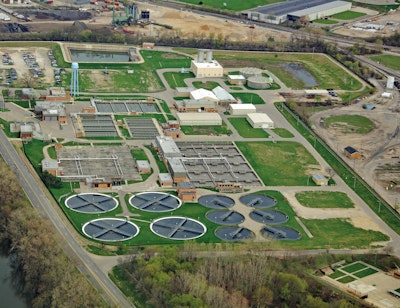
The Grand River in Grand Rapids, Michigan, was in bad shape years ago from sewer overflows caused by excess inflow and infiltration. A robust network of flow meters and rain gauges analyzed by a BLU-X Intelligent Urban Watershed platform has helped clean up the problems.
Interested in Flow Control?
Get Flow Control articles, news and videos right in your inbox! Sign up now.
Flow Control + Get AlertsBy using sensors to collect real-time data about the performance of sanitary sewers and a specialized software program to analyze the intel, the city of Grand Rapids, Michigan, avoided an estimated $1 billion worth of system upgrades that reports indicated would be needed to ensure compliance with state mandates.
The data was collected by a network of 90 flowmeters and 10 rain gauges deployed around the city in 2013 and analyzed by a BLU-X Intelligent Urban Watershed platform from Xylem Digital Solutions. The upshot? The infiltration and inflow problems could instead be solved for between $30 million to $50 million, says Nicole Pasch, the acting assistant environmental services manager for the city’s Environmental Services Department.
“The real-time sensors turned on the lights,” Pasch says. “We used the technology to clarify and prove things. It was risky to spend $2 million to deploy flowmeters out there, but if we hadn’t, it would’ve affected the affordability of our water and sewer services in a very negative way.”
The city’s journey to using the sensors and the analytical software actually started back in 1991. That’s when Grand Rapids embarked on a 27-year-long, roughly $400 million endeavor to convert its 100-year-old combined sewers into separate stormwater and sanitary sewers. Overall, the city installed about 119 miles of new storm and sanitary sewer lines in a 4.7-square-mile area and separated 99.5% of the old combined sewer network.
Sewer overflows during heavy rains had plagued the city for decades. During 1969, for instance, 12.6 billion gallons of untreated sewage flowed into the Grand River, which empties into Lake Michigan some 40 miles downstream. And in 2013, record flooding sent 435 million gallons of untreated sewage into the river, according to news reports.
In fact, the situation was bad enough that in 1988, state authorities imposed a ban on real estate development until the sewer problems were fixed. The state also ordered the city to fix the sewer overflow problem by 2019.
Surprising news
After the sewer-separation project concluded, the city was required to prove it could comply with a mandate from the Michigan Department of Environmental Quality to eliminate overflows in the new sanitary sewers. The only exception to the mandate was a rainstorm that would exceed a 24-hour, 25-year storm, about the equivalent of almost 4 inches of rain in an hour, Pasch says.
“Even though we already spent $400 million to separate the sewers and no longer have any sewage overflow, we still have to go through the regulatory requirement to show we won’t have any sanitary system overflows,” Pasch explains.
When the hydraulic modeling test was completed, the results took officials by surprise. The data indicated that the city still needed to remove 175 million gallons of I&I from the system annually. At a cost of $5 to $7 per gallon for such projects, the total estimated price tag came out to around $1 billion, Pasch says.
“After reviewing the results, it was surprising that the hydraulic model indicated there were more areas that still needed work, including some areas we had already addressed,” she says. “The model predicted much bigger issues with certification than we ever thought possible.”
Following a hunch
At that point, officials faced a choice: Accept the results of the hydraulic model or follow a gut hunch that the modeling was somehow flawed. They elected to go with the latter, and to verify their hunch, the city hired EmNet (now owned by Xylem) to deploy the flow sensors in 2013.
“The more we worked with EmNet, the more we realized that they’re very experienced in modeling and collecting system intelligence,” Pasch says. “So we hired them to develop a more realistic model.”
The centerpiece of EmNet’s efforts was the BLU-X platform, which collects, organizes, analyzes and displays the data via dashboards. That provides municipal officials with visual cues to understand and regulate the operation of their sewer systems. Once a baseline model was established, this “smart” system continually compares it against ongoing sensor data, which continuously fine-tunes the model with each rainfall.
“The model is built on a software platform that is basically a series of mathematical relationships that represent the entire sewer system,” says Tim Braun, vice president and enterprise architect at Xylem Digital Solutions. “It models how all the pipes intersect, their slopes and diameters — really anything that impacts how water flows through the system.
“BLU-X helps you understand the physical locations of the problem and characterizes the behavior of a sewer system,” he adds. “This helps you understand the location of the biggest pain points, and knowing that helps you make far more strategic decisions.”
Not as bad as expected
The flowmeter data analytics provided by the BLU-X platform narrowed the problem areas suggested by the hydraulic study to only six sites. And even those six sites struck city officials as odd because during the major flooding that afflicted much of the Midwest in 2016, none occurred in the areas that the data predicted would suffer most, Pasch says.
“We took all that data from the flowmeter network and used it to show where they were getting the most inflow from direct connections, as well as groundwater infiltration,” Braun says. “That body of data and analytics was very different from what the hydraulic model said should’ve been happening.”
After moving flowmeters to new locations and analyzing more data, the city narrowed down the problem sites to just three. “That’s where the real story is,” Pasch explains. “It’s all about trusting your experience and your gut about the aberrations.
“A basic hydraulic model is very conservative, so we took the next step of putting meters out there and getting real data,” she continues. “Then the modeling advanced to a neural network and from there to a genetic algorithm model.
“Using those kinds of advanced mathematical computations allows the system to calibrate more and more to what it actually sees, rather than relying on theoretical computations.”
Verify with data
So what’s the takeaway here for other municipal officials? “As an operator, you know your system, so sometimes you have to follow your gut instincts and verify them with data,” Pasch notes.
The data collected and the ensuing analytics allowed the city to make an intelligent and articulate case to the state Department of Environment, Great Lakes and Energy to avoid spending $1 billion in sanitary sewer improvements, Braun says, while still meeting its sewer performance requirements and environmental objectives.
Looking ahead, the city has installed 70 more sensors, this time primarily in storm sewers. The data collected by the sensors will help Grand Rapids officials understand the city’s overall impact on the Grand River and identify what projects will yield the highest return on investment as they pertain to water quality in the river and its tributaries.
“Grand Rapids is one of the most advanced cities in the country. They’re way ahead of the game in terms of making necessary investments in sewers,” Braun notes.
In the meanwhile, the city has completed the project-performance certification process to demonstrate that all the separated sewers meet state mandated requirements. The storm sewers are certified, but the sanitary sewers certification is pending.
“The city submitted a project-performance certification work plan (for the sanitary sewers) at the end of 2019, and we expect it will be accepted,” Pasch says. “That will save the city hundreds of millions of dollars by using the updated model and real-time data.
“We could’ve spent $1 billion,” she concludes. “But instead, we found a better and more cost-efficient way.”







